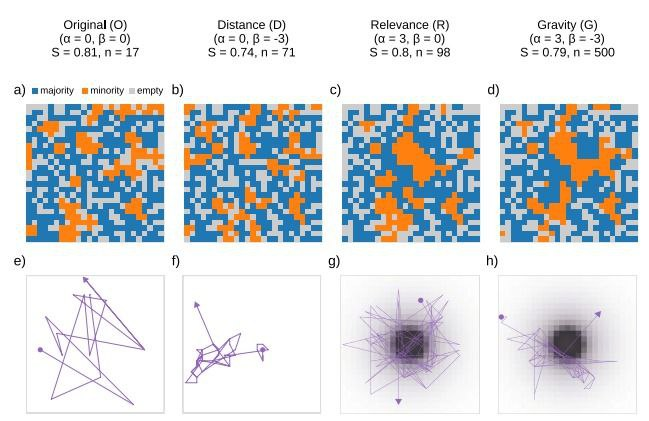Urban segregation of people: a new study improves the model of virtual moving citizens in support of policymakers
Segregation of people in urban contexts, i.e., the trend that people have to aggregate or separate into groups according to the presence or the lack of similar people, is a long-studied phenomenon. In fact, understanding urban segregation is crucial for policymakers to prevent negative social consequences such as limited access to quality education, healthcare, and employment opportunities.
A new study by Daniele Gambetta [1,2], Giovanni Mauro [1,2,3], and Luca Pappalardo [1] published in Scientific Reports introduces methodological improvement on the most common mathematical model of urban segregation used to understand and predict urban segregation scenarios.
"Understanding urban segregation, which refers to the spatial separation and concentration of different social groups within an urban area, is of paramount importance, given its impact on various social, economic, and cultural facets of our society," says Giovanni Mauro. "High levels of segregation lead to limited access to quality education, healthcare, and employment opportunities for marginalized communities, exacerbating socioeconomic disparities and hindering social mobility. Additionally, concentrated poverty resulting from segregation strains public resources, contributes to a higher crime rate, and fosters social isolation, further impeding community development and cohesion. Modeling segregation provides a powerful tool for conducting what-if analyses, understanding social inequities, facilitating integration, and promoting social cohesion."
The authors developed their model starting from the most commonly used segregation model. They changed the criteria according to whom people surrounded by a certain number of neighbors different enough from them, the so-called unhappy agents, decide to move.
"The scientific foundations of our work are rooted in our expertise, human mobility analysis. The Schelling model has been widely extended since its release in 1971. We studied it from the perspective of a human mobility analyst to understand how the model's inner dynamics can be better modeled."
In the original Schelling's segregation model, unhappy agents can relocate to every cell in the city (modeled as a grid). The authors postulated an improvement of the simulation by introducing the main law of human mobility, the Gravity model. According to the Gravity model, people choose to move to a specific location, preferring short distances and high-opportunities density locations. That leads to a more accurate provisional capability for people moving into a city.
"Taking into account mobility in Schelling's like dynamic, we discovered that if we give importance to the parameter that controls the movement (i.e., a scenario in which people don't want to go far away) and to the one that controls the relevance (i.e., a scenario in which agents want to go in the most relevant place: the city center), we observe an elongation in segregation times.
The consequence is that the fast and abrupt segregation phenomenon observed by Schelling results smoothed out. This highlights the importance of studying and considering the intricate mechanisms that govern a city's complex environment."
This new approach aims to capture the realistic behavior of individuals in real cities, where the distance and the attractiveness of each place play crucial roles in determining where people choose to live.
The authors' findings provide valuable insights into the complex dynamics of segregation. The improvements introduced make it possible to simulate different scenarios and understand how they impact segregation levels more accurately. For example, it should be possible to explore how economic incentives, the relocation of facilities, or some limitations to mobility impact segregation. This approach can help policymakers make informed decisions about how to address segregation.
The challenges to further improve the prediction capability of segregation models are many. For example, the current model overlooks other factors contributing to overall happiness, such as socioeconomic status, housing conditions, and neighborhood composition. Furthermore, the work is purely simulative, and, at the moment, no data are involved.
"Future research could incorporate more complex assumptions and consider additional factors. For example, agents could consider several attributes of origin and destination cells, such as cell centrality and the presence of specific venues, when making relocation decisions. In addition, there is potential for exploring alternative mechanisms of agent mobility. Lastly, we aim to extend the analysis to a real-world dataset of relocations to assess how simulation-based results align with empirical observations in an actual city.”
The authors’ future goals are to replicate the relevance distribution of a known city and fit a mobility model on some real relocation data to run the model on a real-world scenario and search for some hidden emergent phenomena.
“Segregation is a complex issue that influences and is influenced by a wide range of factors, including economics, housing, transportation, and culture, but it is one that we need to address to create a more just and equitable society."
1 Institute of Information Science and Technologies, National Research Council (ISTI-CNR), Pisa, Italy.
2 University of Pisa, Pisa, Italy.
3 IMT School for Advanced Studies, Lucca, Italy.
Email: daniele.gambetta@phd.unipi.it; giovanni.mauro@phd.unipi.it; luca.pappalardo@isti.cnr.it

